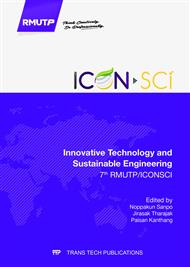p.8
p.12
p.17
p.21
p.25
p.29
p.33
p.37
p.41
Beneficial Effects of Zinc Oxide Nanoparticles on Plant Regeneration of Vetiver Grass (Vetiveria zizanioides L. Nash)
Abstract:
Zinc is an essential micronutrient element for plant. Nowadays, Zinc oxide nanoparticles (ZnO NPs) are widely used and have been shown adverse effects to plant physiology. The optimal concentration of ZnO NPs added in plant regeneration medium (PRM) is studied in this experiment. Six-weeks old calli induced from the aseptic axillary buds of vetiver grass were cultured in PRM with various concentrations of ZnO NPs (5, 10, 20, 40 mgL-1). PRM containing 5, 10 mgL-1 ZnO NPs showed the highest percentage of plant regeneration frequency (95%) but did not have a statistic difference with other treatments. However, the averages of shoot length regenerated under both concentrations were 1.32-1.33 cm. These averages of shoot length had statistically different from averages of shoot length of the others. Moreover, calli regenerated under PRM containing 5 mgL-1 ZnO NPs condition showed the highest average number of shoots per callus (9.75 shoots) with a statistic difference. ZnO NPs at 20-40 mgL-1 in the PRM did not enhance the percentage of plant regeneration, but retarded calli development and shoot elongation. The optimal concentration of ZnO NPs in PRM has positive effects on regeneration and development of vetiver grass under tissue culture condition.
Info:
Periodical:
Pages:
25-28
Citation:
Online since:
June 2017
Authors:
Keywords:
Price:
Сopyright:
© 2017 Trans Tech Publications Ltd. All Rights Reserved
Share:
Citation:


